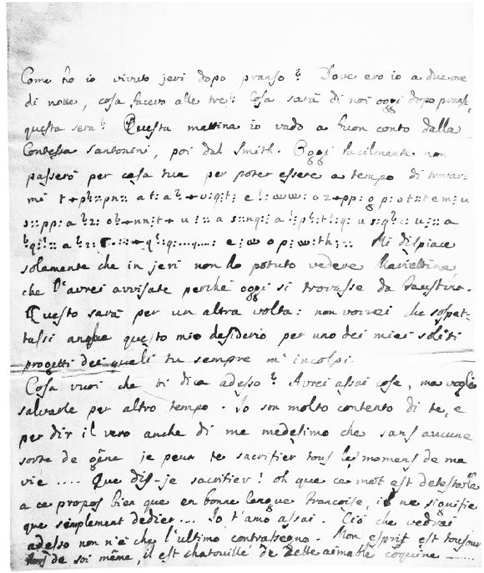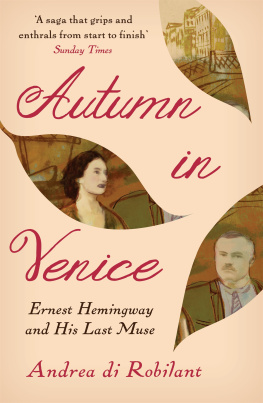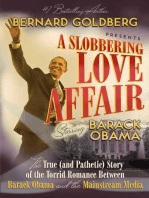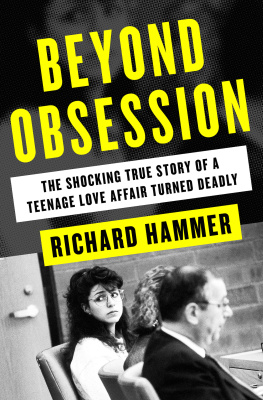

Table of Contents
Acclaim for Andrea di Robilants
A VENETIAN AFFAIR
Spectacular.... Plunges into the comic-opera world of eighteenth-century Venetian high society.... All who have drunk from the poisoned chalice of forbidden love will recognize something of themselves here.
Elle
The best novel Ive read in years... except that it happens to be true.... So immediate, vivid, and powerful that it takes you inside the minds and, indeed, the bodies of its two passionate protagonists.... Unforgettable.
Simon Schama, author of A History of Great Britain
Delicious and unique, marrying the vicarious thrill of reading someone elses love letters with the... color of Casanovas eighteenth-century Venice.
Philadelphia City Paper
Rarely does [a love story] emerge from historys pages with the immediacy found in [di Robilants] A Venetian A fair.... Spellbinding.
Vogue
An enchantment. Andrea di Robilant hasnt just brought a splendid Venetian love affair to life, he has brought eighteenth-century Europe to life, both intimately and grandly. This is narrative history at its very best.
John Casey, author of The Half-life of Happiness
Moving.... Brings alive eighteenth-century Venice.
Newsday
Compelling.... Delight and romance lie in the forbidden language of the letters.... A love story not only passionate, but saucy, chimerical, impudent, ardent and tragic.
The Observer (London)
Conveys the climate of scandal and intrigue that made romance so interesting in mid-eighteenth-century Europe and reminds us how wonderfully obstacles inflame and sustain passion.
The Boston Globe
Andrea di Robilant brilliantly evokes Venice in the age of Casanova-masked balls, elegant salons, louche casinos, and social, political, and romantic intrigue. A Venetian A fair is luminous, erotic, and utterly spellbinding.
John Berendt, author of Midnight in the Garden of Good and Evil
Remarkable.... Exhilarating.... [These] love letters bring characters to life as no other writing can.
The Guardian (London)
The reality of these two flesh and blood lives is never in doubt. They remind us that loves pleasures and pains are timeless.
The Dallas Morning News
Andrea di Robilant narrates with precision and obvious affection the world he re-creates.
The Trenton Times
A sophisticated work of Belles Lettres.... [Di Robilant has] a journalists nose for intrigue and a novelists ear and eye for evocation.... A delicious literary feast.
The Globe & Mail (Toronto)
[Di Robilant] does more than merely quote their words. Interweaving dramatic scenes and keenly observed passages, he creates a narrative of novelistic resonance.
Newark Star-Ledger
Fascinating.... Seductive.... An irresistible tale of two innocents wounded by Cupids ill-aimed arrows.... If, in this jaded age, any hopeless romantics remain... their spirits will be fortified by A Venetian A fair.
Nashville Scene

Prologue
Some years ago, my father came home with a carton of old letters that time and humidity had compacted into wads of barely legible paper. He announced that he had found them in the attic of the old family palazzo on the Grand Canal, where he had lived as a boy in the twenties. Many times, my father had enthralled my brothers and me with stories from his enchanted childhoodthere had been gondola rides and childrens tea parties and picnics at the Lido, and in the background the grown-ups always seemed to be drinking champagne and giving fancy-dress balls. Equally romantic to us, though much more melancholy, was his account of how my grandparents lavish and extravagant lifestyle had begun fraying at the edges. By the early thirties, art dealers were dropping by more and more frequently. Large empty patches appeared on the walls. Pieces of antique furniture were carried out of the house. Even the worn banners and rusty swords our fierce ancestors had wrested from the hated Turks were sold at auction. Eventually, my spendthrift grandfather sold off the palace floor by floor, severing the family ties to Venice and leaving my father so bereft that he yearned for his Venetian heritage for the rest of his life. He never lived in Venice again, but even as an older man he continued to make nostalgic pilgrimages to the places of his childhood and especially to that grand old house, which had long ceased to belong to us, but where the family still kept a few old boxes and crates.
The di Robilant family is actually of Piedmontese origin. The Venetian connection was established at the end of the nineteenth century when Edmondo di Robilant, my very tall and rather austere great-grandfather from Turin, married my great-grandmother Valentina Mocenigo, a formidable Venetian grande dame with beautiful black eyes and a very sharp tongue. The Mocenigos were one of the old ruling families of Venicethey gave seven doges to the Republic my father never tired of repeating to us children. Of course, the glorious days of the Venetian Republic were long gone when my great-grandparents married, but the last Mocenigos still had palaces and money and beautiful paintings. So the impecunious di Robilants moved to Venice after World War I and fairly quickly ran through what remained of the Mocenigo fortune.
My father, having grown up in the fading grandeur of Palazzo Mocenigo, came to revere his Venetian ancestry more than the Piedmontese. To him the box of letters was a small treasure he had miraculously retrieved from his Venetian past. And I remember well the look of cheerful anticipation he had on his face when he arrived at our house in Tuscany and placed it on the dining room table for all the family to see.
The letters were badly frayed and had wax marks and purplish traces of wine on them. They looked intriguing. They were not the usual household inventories that occasionally surfaced, like timeworn family flotsam, in some forgotten recess of the palazzo in Venice. We pried them open one by one and soon realized they were intimate love letters that dated back to the 1750s. Some pages were covered with mysterious hieroglyphs that added mystery to my fathers discovery. We spent a rainy weekend cracking the strange cipher and trying to make some sense of the first fragments we were able to read. I remember we were wary of delving into secrets buried so long ago. Yet we labored on because the spell was irresistible.
At the end of that long weekend I went back to Rome, where I was then working as a journalist, while my father took on the task of deciphering and transcribing the cache of one hundred or so letters in his possession. What eventually emerged from his painstaking labor was the remarkable love story between our ancestor Andrea Memmo, scion of one of the oldest Venetian families, and Giustiniana Wynne, a bright and beautiful Anglo-Venetian of illegitimate birth. The letters revealed a deep romantic passion that was at odds with the gallant, lighthearted lovemaking one often thinks of as typical of the eighteenth century. It was also, very clearly, a clandestine relationship: the curious-looking dots and circles and tiny geometric figures scribbled across the pages were a graphic testimony to the fear the two lovers must have felt lest their letters fall into the wrong hands.
Next page










